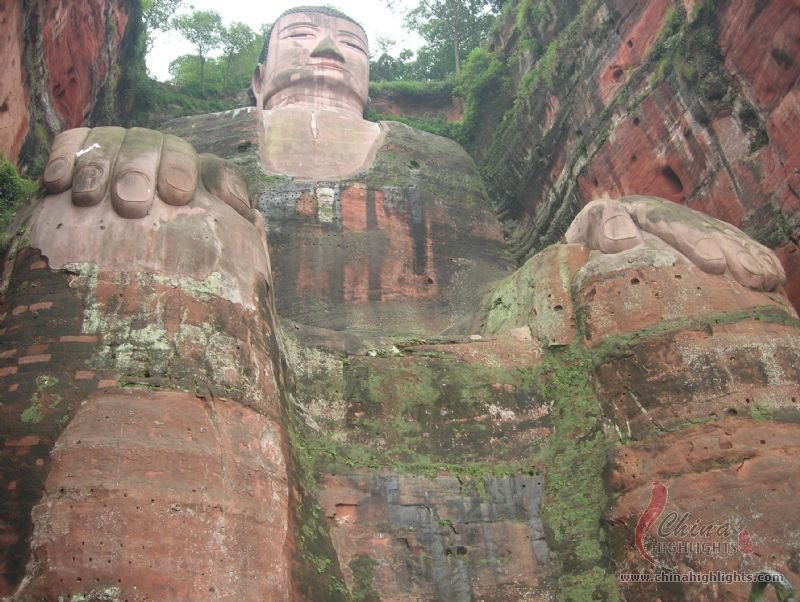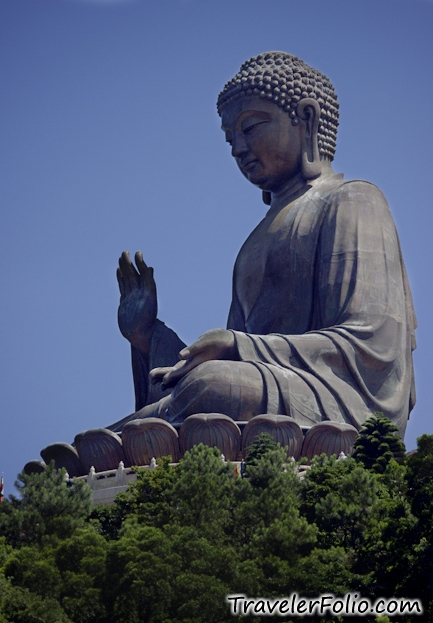Wonders of the World
Thursday 24 May 2012
Sunday 29 April 2012
Leshan Giant Buddha
 The Leshan Giant Buddha is a giant stone Buddha that was created during the Tang Dynasty (618-907AD), it is carved out of the cliff face that lies at the confluence of the Minjiang, Dadu and Qingyi rivers in the southern part of Sichuan province in China, near the city of Leshan. It faces Mount Emei with the river flowing beneath the feet of the stone sculpture as it is the largest carved stone Buddha in the world and listed as the tallest pre-modern statue in the world. Because of this extraordinary feat of human ingenuity the Leshan Giant Buddha has been listed on the UNESCO World Heritage Site since 1996.
The Leshan Giant Buddha is a giant stone Buddha that was created during the Tang Dynasty (618-907AD), it is carved out of the cliff face that lies at the confluence of the Minjiang, Dadu and Qingyi rivers in the southern part of Sichuan province in China, near the city of Leshan. It faces Mount Emei with the river flowing beneath the feet of the stone sculpture as it is the largest carved stone Buddha in the world and listed as the tallest pre-modern statue in the world. Because of this extraordinary feat of human ingenuity the Leshan Giant Buddha has been listed on the UNESCO World Heritage Site since 1996. Construction for this wonder began in 713 led by a Chinese monk named Haitong who wanted to make this stone sculpture because he hoped that by creating this sculpture that the waters would be calmed since they were turbulent and were causing problems for the trading ships. However there were insufficient fundings for the project and when Haitong heard that he gouged out his own eyes to demonstrate his piety and sincerity but Haitong died before the construction was completed and the project was halted until 70 years later when a Jiedushi, a military governor, decided to sponsor the project and it was completed in 803 by Haitong’s disciples; coincidently the waters where the statue was built became safe for ships to travel on.
Construction for this wonder began in 713 led by a Chinese monk named Haitong who wanted to make this stone sculpture because he hoped that by creating this sculpture that the waters would be calmed since they were turbulent and were causing problems for the trading ships. However there were insufficient fundings for the project and when Haitong heard that he gouged out his own eyes to demonstrate his piety and sincerity but Haitong died before the construction was completed and the project was halted until 70 years later when a Jiedushi, a military governor, decided to sponsor the project and it was completed in 803 by Haitong’s disciples; coincidently the waters where the statue was built became safe for ships to travel on.However over the years the statue has slowly been degraded by the weather and pollution, this not only includes the Leshan Giant Buddha but also other cultural and important heritage sites all over China due to the heavy pollution in China. The government has vowed to restore the wonder to it’s former glory.
Some facts about the Leshan Giant Buddha:
. It is 71 meters tall
. There are several passages hidden in the Buddha's hair, collar, chest, and holes in the back of his ears preventing the Buddha from serious erosion and weathering. He has been lovingly maintained on a regular basis throughout his 1,200-year history, but is still a bit mossy
. It’s smallest toenail can seat a person
Tian Tan Buddha
 The Tian Tan Buddha is a large bronze Buddha statue that was completed in 1903 and now sits at Ngong Ping, Lantau Island, in Hong Kong. It is located near Po Lin Monastery and symbolises the harmonious relationship between man and nature, people and religion. Construction began in 1990 and finished within three years on December of 1993, which is also the day that the founder of Buddhism attained Enlightenment, the statue was formed out of 202 separate pieces of bronze. In addition to the exterior components, there is a strong steel framework inside the statue to support the heavy load. When the statue was completed, monks from around the world were invited to the opening ceremony. Distinguished visitors from mainland China, Hong Kong, Taiwan, India, Japan, Korea, Thailand, Malaysia, Singapore, Sri Lanka, and the United States all took part in the proceedings.
The Tian Tan Buddha is a large bronze Buddha statue that was completed in 1903 and now sits at Ngong Ping, Lantau Island, in Hong Kong. It is located near Po Lin Monastery and symbolises the harmonious relationship between man and nature, people and religion. Construction began in 1990 and finished within three years on December of 1993, which is also the day that the founder of Buddhism attained Enlightenment, the statue was formed out of 202 separate pieces of bronze. In addition to the exterior components, there is a strong steel framework inside the statue to support the heavy load. When the statue was completed, monks from around the world were invited to the opening ceremony. Distinguished visitors from mainland China, Hong Kong, Taiwan, India, Japan, Korea, Thailand, Malaysia, Singapore, Sri Lanka, and the United States all took part in the proceedings.Po Lin Monastery and the Buddha are open to the public between 10:00 and 17:45. Access to the outside of the Buddha is free of charge, but there is an admission fee to go inside the Buddha.
 Visitors may also see the nearby monastery, known as the "Buddhist Kingdom in the South," which serves as an international Buddhist retreat, and is one of the largest and most well known in Hong Kong. The monastery was built by three Zen masters in 1920. The main temples have painted vermilion interiors with dragons and many other different Chinese mythical figures on the walls and ceilings. Visitors often spend time in the attached tea garden, the only tea garden in the territory. A five minute walk past the tea garden leads to the "Wisdom Path" - a very large wooden inscription of the Heart Sutra set within a figure 8 to symbolise infinity. One of the main attractions of this Buddha statue is climbing 268 steps and circling the platform (the lotus) where the Buddha sits.
Visitors may also see the nearby monastery, known as the "Buddhist Kingdom in the South," which serves as an international Buddhist retreat, and is one of the largest and most well known in Hong Kong. The monastery was built by three Zen masters in 1920. The main temples have painted vermilion interiors with dragons and many other different Chinese mythical figures on the walls and ceilings. Visitors often spend time in the attached tea garden, the only tea garden in the territory. A five minute walk past the tea garden leads to the "Wisdom Path" - a very large wooden inscription of the Heart Sutra set within a figure 8 to symbolise infinity. One of the main attractions of this Buddha statue is climbing 268 steps and circling the platform (the lotus) where the Buddha sits.Some facts about the Tian Tan Buddha:
- Constructed from 202 bronze pieces
- Weighs over 250 tonnes
- Is 34 meters high
- Sits atop 268 steps
Leaning Tower of Pisa
Leaning tower of Pisa
The leaning Tower of Pisa is famous
because it leans. Although it was designed to be perfectly vertical it started
to lean during constructions. However, even without this famous characteristic
this building would still be on e of the most remarkable architectural
structures. It stands at 60 metres at about 10 degree angle.
Tower of Pisa is more accurately reffered
to simply as the bell tower. The Pisa
tower is one of the four buildings that make up the cathedral complex in Pisa,
Italy, called Camp dei Miracoli , which means Field of Miracles.
The leaning Tower of Pisa is the crowning
glory. Although only a third as high as the Washington Monument, it was a
miracle of engineering with 207 columns ranged around eight stories.
The construction of Tower of Pisa began in
August 1173 and continued for about 200 years due to a series of war. Until
today, the name of the architect is a mystery. The leaning Tower of Pisa was
designed as a circular bell tower that would stand 185 feet high. It is
constructed of white marble. The tower has eight stories, including the chamber
for the bells. The bottom story consists of 15 marble arches. Each of the next
six stories contains 30 arches that surround the tower. The final story is the
bell chamber itself, which has 16 arches. There is a 297 step stpiral staircase
inside the tower leading to the top.
The top of the leaning tower of Pisa is
about 17 feet off the vertical. The tower is also slightly curved from attempts
by various architects to keep it from leaning more or falling over.
Many ideas have been suggested to
straighten the Tower of Pisa, including taking it apart stone by stone and
rebuilding it at different location. In the 1920’s the foundations of the tower
were injected with cement grouting that has stabilized the tower to some
extent.
Until recent years tourists were not
allowed to climb the staircase inside the tower, due to consolidation work. But
now the leaning Tower of Pisa is open again and it is one of the wonders of the
great architect in the world.
Ishtar Gate
Reconstruction Glazed Brick
Total Height–47 Feet, Width-32 Feet
Neo-Babylonian
7th–6th Centuries BC
Dedicator: Nebuchadnezzar II
Language: Akkadian
Date of Excavation: 1899-1914
Staatliche Museen , Berlin
Dept. of the Near EastThe Ishtar Gate, one of the eight gates of the inner city of Babylon, was built during the reign of Nebuchadnezzar II (604- 562 BC). Only the foundations of the gate were found with 45 feet. The gateway has been reconstructed in the Pergamon Museum, Berlin, from the glazed bricks found, so its original height is different in size. Reconstructed height is 47 feet.
It was one of the eight gates of the inner city of Babylon. It was built in about 575 BC, the eighth fortified gate in the city. It is one of the most impressive monuments rediscovered in the ancient Near East. The Ishtar gate was decorated with glazed brick reliefs, in tiers, of dragons and young bulls. The gate itself was a double one, and on its south side was a vast antechamber. Through the gatehouse ran a stone-and brick-paved avenue called Processional Way, which has been traced over a length of more than half a mile.
KNebuchadnezzar II of Babylon dedicated the great Ishtar Gate to the goddess Ishtar. It was the main entrance into Babylon. King Nebuchadnezzar II performed elaborate building projects in Babylon around 604-562 BC. His goal was to beautify his capital. He restored the temple of Marduk, the chief god, and also built himself a magnificent palace with the famous Hanging Gardens.
It is believed that Nebuchadnezzar who destroyed Jerusalem, brought the kingdom of Judah to an end. The Ishtar Gate was the starting point for protest. The Babylonians would assemble in front of it and march through the arch and proceed along.
‘Reliefs of Lions’
The gateway was
completely covered with beautifully colored glazed bricks. Its reliefs of
dragons and bulls symbolized the gods Marduk and Adad. In front of the gateway
outside the city was a road with walls decorated with reliefs of lions and
glazed yellow tiles. The Ishtar gate was reconstructed in Berlin.
Subscribe to:
Posts (Atom)




